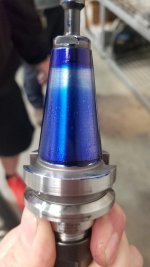Hi All,
I need a sanity check. I have a 2018 DT-2 Mill with a 20,000 RPM Spindle. We use it mostly for endmills and drills under 0.125" in aluminum. There is one operation that we did that required a 0.375" 3 flute endmill with a 37 deg. helix. The cut parameters are 13,250 RPM at 180 IPM. Ap is 0.800" and Ae is 0.056". The operation is milling a hole thru the part with an adaptive stratagy. A starter hole is already drilled in the center. Material is 7075 T6 Aluminum. The issue I am having is really nasty fretting on the tool tapers. I checked the pull studs, pull stud torque, Tool runout, and changed to a different holder. Results were the same. I decided to check the taper with some Dykem Hi-Spot blue and I really think that this machine has the taper ground like crap. This is a brand new machine and there are 46 hours on this spindle. I know im a bit heavy with my blue but the results are pretty clear in my mind. At least I think. I contacted my HFO and they think that I am being too aggressive with a BT30 Machine. I call BS.


Any advise on this would be appreciated.
I need a sanity check. I have a 2018 DT-2 Mill with a 20,000 RPM Spindle. We use it mostly for endmills and drills under 0.125" in aluminum. There is one operation that we did that required a 0.375" 3 flute endmill with a 37 deg. helix. The cut parameters are 13,250 RPM at 180 IPM. Ap is 0.800" and Ae is 0.056". The operation is milling a hole thru the part with an adaptive stratagy. A starter hole is already drilled in the center. Material is 7075 T6 Aluminum. The issue I am having is really nasty fretting on the tool tapers. I checked the pull studs, pull stud torque, Tool runout, and changed to a different holder. Results were the same. I decided to check the taper with some Dykem Hi-Spot blue and I really think that this machine has the taper ground like crap. This is a brand new machine and there are 46 hours on this spindle. I know im a bit heavy with my blue but the results are pretty clear in my mind. At least I think. I contacted my HFO and they think that I am being too aggressive with a BT30 Machine. I call BS.



Any advise on this would be appreciated.




